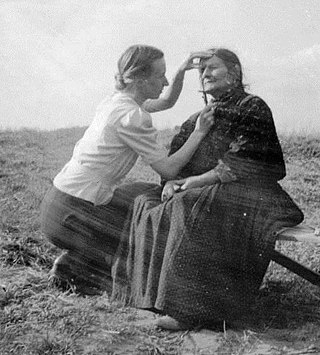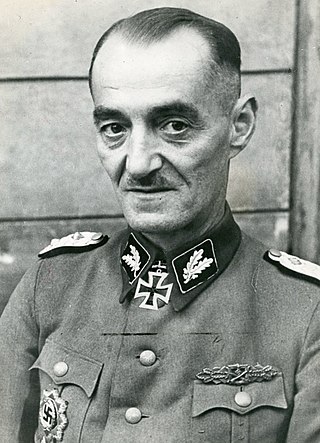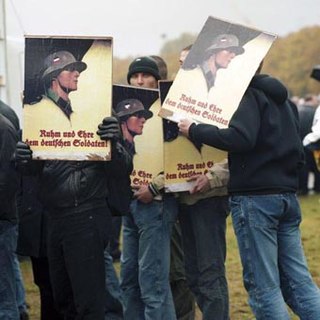
The racial policy of Nazi Germany was a set of policies and laws implemented in Nazi Germany under the dictatorship of Adolf Hitler, based on pseudoscientific and racist doctrines asserting the superiority of the putative "Aryan race", which claimed scientific legitimacy. This was combined with a eugenics program that aimed for "racial hygiene" by compulsory sterilization and extermination of those who they saw as Untermenschen ("sub-humans"), which culminated in the Holocaust.

Yosef YitzchakSchneersohn was an Orthodox rabbi and the sixth Rebbe of the Chabad Lubavitch Hasidic movement. He is also known as the Frierdiker Rebbe, the Rebbe RaYYaTz, or the Rebbe Rayatz. After many years of fighting to keep Orthodox Judaism alive from within the Soviet Union, he was forced to leave; he continued to conduct the struggle from Latvia, and then Poland, and eventually the United States, where he spent the last ten years of his life.
Mischling was a pejorative legal term which was used in Nazi Germany to denote persons of mixed "Aryan" and non-Aryan, such as Jewish, ancestry as they were classified by the Nuremberg racial laws of 1935. In German, the word has the general denotation of hybrid, mongrel, or half-breed. Outside its use in official Nazi terminology, the term Mischlingskinder was later used to refer to war babies born to non-white soldiers and German mothers in the aftermath of World War II.

Oskar Dirlewanger was a German SS commander and habitual offender, convicted of rape and other crimes. He is known for committing numerous war crimes in German-occupied territories during World War II. Dirlewanger was the founder and commander of the SS penal unit, the Dirlewanger Brigade, considered to be the most brutal and notorious Waffen-SS unit. His unit epitomized the expansion of the war of terror in its most brutal form within the SS, and with Dirlewanger himself regarded as perhaps the Nazi regime's "most extreme executioner", indulging himself in sadistic acts of violence, rape and murder.
A German Blood Certificate was a document provided by Nazi leader Adolf Hitler to Mischlinge, declaring them deutschblütig. This practice was begun sometime after the Nuremberg Laws of 1935, and allowed exemption from most of Germany's racial laws.
The functionalism–intentionalism debate is a historiographical debate about the reasons for the Holocaust as well as most aspects of the Third Reich, such as foreign policy. It essentially centres on two questions:

Werner Goldberg was a German of half Jewish ancestry, or Mischling in Nazi terminology, who served briefly as a soldier during World War II. His image appeared in the Berliner Tageblatt as "The Ideal German Soldier", and was later used in recruitment posters and propaganda for the Wehrmacht.

The Law for the Restoration of the Professional Civil Service, also known as Civil Service Law, Civil Service Restoration Act, and Law to Re-establish the Civil Service, was enacted by the Nazi regime in Germany on 7 April 1933. This law, which followed Adolf Hitler's rise to power by two months and the promulgation of the Enabling Act by two weeks, constituted one of the earliest instances of anti-Semitic and racist legislation in Germany.

The Nuremberg Laws were antisemitic and racist laws that were enacted in Nazi Germany on 15 September 1935, at a special meeting of the Reichstag convened during the annual Nuremberg Rally of the Nazi Party. The two laws were the Law for the Protection of German Blood and German Honour, which forbade marriages and extramarital intercourse between Jews and Germans and the employment of German females under 45 in Jewish households; and the Reich Citizenship Law, which declared that only those of German or related blood were eligible to be Reich citizens. The remainder were classed as state subjects without any citizenship rights. A supplementary decree outlining the definition of who was Jewish was passed on 14 November, and the Reich Citizenship Law officially came into force on that date. The laws were expanded on 26 November 1935 to include Romani and Black people. This supplementary decree defined Romani people as "enemies of the race-based state", the same category as Jews.

Honorary Aryan was a semi-official category and expression used in Nazi Germany to justify the exceptional awarding of Aryan certificates to some regime-favoured Mischlinge who according to Nuremberg Laws standards would not have been recognized as belonging to the Aryan race, but whom German officials nevertheless chose to spare persecution.

During World War II, the German Wehrmacht committed systematic war crimes, including massacres, mass rape, looting, the exploitation of forced labour, the murder of three million Soviet prisoners of war, and participated in the extermination of Jews. While the Nazi Party's own SS forces was the organization most responsible for the genocidal killing of the Holocaust, the regular armed forces of the Wehrmacht committed many war crimes of their own, particularly on the Eastern Front.
Holocaust victims were people targeted by the government of Nazi Germany based on their ethnicity, religion, political beliefs, disability or sexual orientation. The institutionalized practice by the Nazis of singling out and persecuting people resulted in the Holocaust, which began with legalized social discrimination against specific groups, involuntary hospitalization, euthanasia, and forced sterilization of persons considered physically or mentally unfit for society. The vast majority of the Nazi regime's victims were Jews, Sinti-Roma peoples, and Slavs but victims also encompassed people identified as social outsiders in the Nazi worldview, such as homosexuals, and political enemies. Nazi persecution escalated during World War II and included: non-judicial incarceration, confiscation of property, forced labor, sexual slavery, death through overwork, human experimentation, undernourishment, and execution through a variety of methods. For specified groups like the Jews, genocide was the Nazis' primary goal.
Responsibility for the Holocaust is the subject of an ongoing historical debate that has spanned several decades. The debate about the origins of the Holocaust is known as functionalism versus intentionalism. Intentionalists such as Lucy Dawidowicz argue that Adolf Hitler planned the extermination of the Jewish people as early as 1918 and personally oversaw its execution. However, functionalists such as Raul Hilberg argue that the extermination plans evolved in stages, as a result of initiatives that were taken by bureaucrats in response to other policy failures. To a large degree, the debate has been settled by acknowledgement of both centralized planning and decentralized attitudes and choices.

Vizefeldwebel Fritz Beckhardt was a German Jewish fighter ace in World War I. The Nazis later expunged him from Luftwaffe history because his valorous war record of 17 aerial victories belied their assertions that Jews were inherently cowardly.
Nazism, the common name in English for National Socialism, is the far-right totalitarian socio-political ideology and practices associated with Adolf Hitler and the Nazi Party (NSDAP) in Germany. During Hitler's rise to power in 1930s Europe, it was frequently referred to as Hitlerism. The later related term "neo-Nazism" is applied to other far-right groups with similar ideas which formed after the Second World War when the Nazi regime collapsed.
Rudolf "Rudi" Schmidt was a highly decorated Major in the Luftwaffe during World War II. He was also a recipient of the Knight's Cross of the Iron Cross. The Knight's Cross of the Iron Cross was awarded to recognise extreme battlefield bravery or successful military leadership.

This is a list of books about Nazi Germany, the state that existed in Germany during the period from 1933 to 1945, when its government was controlled by Adolf Hitler and his National Socialist German Workers' Party. It also includes some important works on the development of Nazi imperial ideology, totalitarianism, German society during the era, the formation of anti-Semitic racial policies, the post-war ramifications of Nazism, along with various conceptual interpretations of the Third Reich.

Helmuth Wilberg was a German officer and a Luftwaffe General of the Air Force during the Second World War. He helped develop the German strategy of blitzkrieg.

The myth of the clean Wehrmacht is the negationist notion that the regular German armed forces were not involved in the Holocaust or other war crimes during World War II. The myth, heavily promoted by German authors and military personnel after World War II, completely denies the culpability of the German military command in the planning and perpetration of war crimes. Even where the perpetration of war crimes and the waging of an extermination campaign, particularly in the Soviet Union – where the Nazis viewed the population as "sub-humans" ruled by "Jewish Bolshevik" conspirators – has been acknowledged, they are ascribed to the "Party soldiers corps", the Schutzstaffel (SS), but not the regular German military.

During a speech at the Reichstag on 30 January 1939, German Führer Adolf Hitler threatened "the annihilation of the Jewish race in Europe" in the event of war:
If international finance Jewry inside and outside Europe should succeed in plunging the nations once more into a world war, the result will be not the Bolshevization of the earth and thereby the victory of Jewry, but the annihilation of the Jewish race in Europe.












